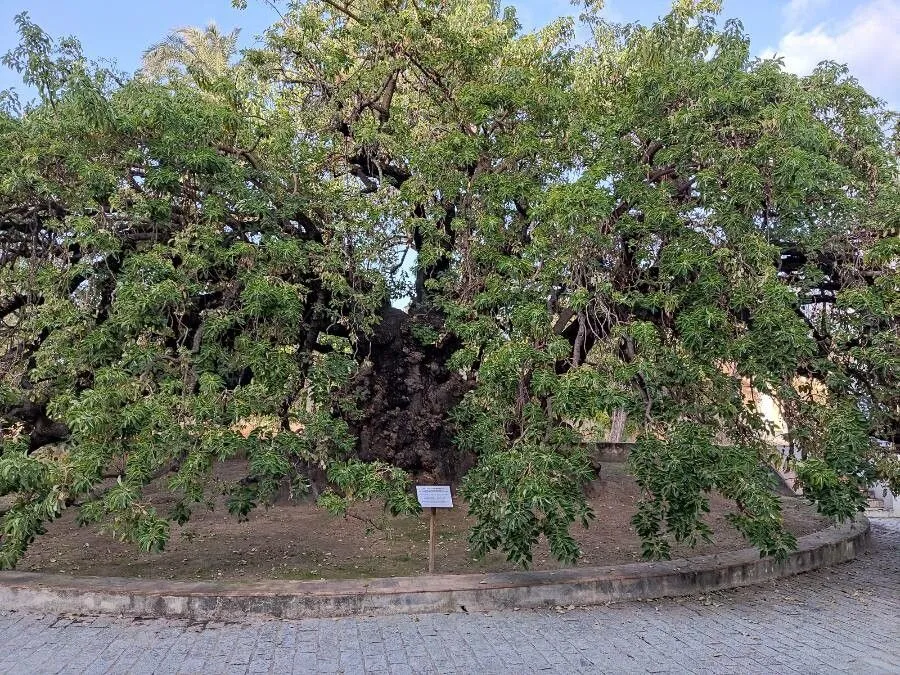
Author: L.
Bibliography: Sp. pl. ed. 2, 1:632. 1762
Year: 1762
Status: accepted
Rank: species
Genus: Phytolacca
Vegetable: False
Observations: Colombia to Brazil and N. Argentina
The majestic Umbratree, scientifically known as Phytolacca dioica, is a remarkable species belonging to the Phytolaccaceae family. Described by the renowned botanist Carl Linnaeus in the second edition of his seminal work “Species Plantarum” in 1762, this tree holds a notable place in botanical literature.
The Umbratree is indigenous to a broad geographical range stretching from Colombia in the north to Brazil and northern Argentina in the south. This wide distribution suggests a high degree of adaptability to various climates and soil types within these regions.
One of the most striking features of the Umbratree is its impressive canopy, which forms a dense, expansive shade – a feature that likely contributed to its common name. The tree’s foliage is a vibrant green, offering a lush canopy that provides shade and shelter to both wildlife and humans alike. The leaves are typically broad and exhibit a rich texture, enhancing the tree’s overall aesthetic appeal.
The trunk of the Umbratree is another point of interest. It is often thick and robust, signifying the tree’s enduring nature and strength. Over time, the bark may develop a rugged texture, adding to the tree’s venerable and majestic appearance.
In its native habitats, the Umbratree plays an integral ecological role. It contributes to the local biodiversity by providing habitat and food for various species of birds, insects, and other wildlife. The tree’s flowers are small and inconspicuous, yet they are vital for the ecosystem, as they attract pollinators, ensuring the continuation of various plant and animal life cycles.
Due to its durability and grandeur, the Umbratree is also valued for ornamental purposes. It is often planted in parks and large gardens where its shade-providing canopy can be fully appreciated. Additionally, its resilience makes it a suitable candidate for urban landscaping in tropical cities.
In conclusion, Phytolacca dioica, or the Umbratree, is a species rich in botanical history and ecological significance. With its widespread presence across northern South America and its adaptability to various environments, it stands as a testament to the resilience and beauty of the natural world.
Fra: belombra, raisinier dioïque
Eng: ombu tree, pokeweed, belhambra, umbratree
Deu: südamerikanische kermesbeere
Spa: bella sombra, ombú
Afr: bobbejaandruifboom
Por: maria-mole, peúdo, umbú
Swe: trädkermes
En: Umbratree, Belhambra, Bella ombre, Ombú, Pokeweed, Ombu tree, Ombu
Af: Bobbejaandruifboom
Eu: Onbu
Ca: Bellaombra
Fi: Puukermesmarja
Fr: Belombra, Raisinier dioïque
Gl: Ombú
De: Südamerikanische Kermesbeere, Maumartige Kermesbeere
Gn: Ombu
It: Cremesina ad albero, Fitolacca arborea
Lt: Nuodingoji fitolaka
Pt: Bela-sombra, Maria Mole, Peúdo, Umbú, Maria-mole
Ru: Лаконос двудомный
Es: Bella sombra, Ombú, Árbol de la bella sombra, Ombu
Sv: Trädkermes
Ta: பெஞ்ச் மரம்
© copyright of the Board of Trustees of the Royal Botanic Gardens, Kew.
© copyright of the Board of Trustees of the Royal Botanic Gardens, Kew.
© copyright of the Board of Trustees of the Royal Botanic Gardens, Kew.
Taken Oct 5, 2021 by Canca (cc-by-sa)
Taken May 15, 2021 by André Hyvrier (cc-by-sa)
Taken May 17, 2021 by Fabrizio Fabrizio Tatti (cc-by-sa)
Taken Aug 16, 2022 by Raúl (Este Madrid) (cc-by-sa)
Taken Jan 26, 2022 by Cabello Manuel Cabello (cc-by-sa)
Taken Feb 14, 2022 by Caspar Lurvink (cc-by-sa)
Taken Feb 25, 2022 by Fabio Serafini (cc-by-sa)
Taken Feb 5, 2022 by Travers Shead (cc-by-sa)
Taken Apr 1, 2022 by Romuald Jamet (cc-by-sa)
Taken Nov 26, 2021 by Gregory Muller (cc-by-sa)
Taken Jul 10, 2011 by huy HO (cc-by-sa)
Taken Jun 2, 2022 by Ketema Mihirete (cc-by-sa)
Taken Jul 20, 2019 by Rivera Gerardo (cc-by-sa)
Taken Sep 10, 2018 by Heinz Gass (cc-by-sa)
Taken Oct 29, 2020 by Aurélie D’huyvetter (cc-by-sa)
Taken Oct 15, 2004 by Photoflora – Jean-Luc TASSET (©)
Taken Aug 15, 1983 by Photoflora – Jean-Luc TASSET (©)
Taken Aug 15, 2001 by Photoflora – Jean-Luc TASSET (©)
Taken Nov 15, 2012 by Photoflora – Jean-Luc TASSET (©)
Taken Jul 10, 2011 by huy HO (cc-by-sa)
Taken Aug 16, 2022 by Raúl (Este Madrid) (cc-by-sa)
Taken Mar 5, 2020 by ayms ja (cc-by-sa)
Taken Dec 14, 2020 by N Z Víctor (cc-by-sa)
Taken Feb 25, 2022 by Fabio Serafini (cc-by-sa)
Taken Feb 21, 2020 by vizinhos do areeiro (cc-by-sa)
Taken Oct 5, 2021 by Canca (cc-by-sa)
Taken Sep 11, 2022 by perez pilar (cc-by-sa)
Taken Dec 14, 2020 by N Z Víctor (cc-by-sa)
Taken Dec 8, 2019 by Figueroa (cc-by-sa)
Taken Oct 19, 2021 by jean-Denis Legal (cc-by-sa)
Ph maximum: 7.0
Ph minimum: 6.5
Light: 8
Atmospheric humidity: 5
Soil nutriments: 4
Family: Myrtaceae Author: (F.Muell.) K.D.Hill & L.A.S.Johnson Bibliography: Telopea 6: 402 (1995) Year: 1995 Status:…
Family: Rubiaceae Author: Pierre ex A.Froehner Bibliography: Notizbl. Bot. Gart. Berlin-Dahlem 1: 237 (1897) Year:…
Family: Sapindaceae Author: Koidz. Bibliography: J. Coll. Sci. Imp. Univ. Tokyo 32(1): 38 (1911) Year:…
Family: Asteraceae Author: A.Gray Bibliography: Pacif. Railr. Rep.: 107 (1857) Year: 1857 Status: accepted Rank:…
Family: Fabaceae Author: Medik. Bibliography: Vorles. Churpfälz. Phys.-Ökon. Ges. 2: 398 (1787) Year: 1787 Status:…
Family: Aspleniaceae Author: (Cav.) Alston Bibliography: Bull. Misc. Inform. Kew 1932: 309 (1932) Year: 1932…